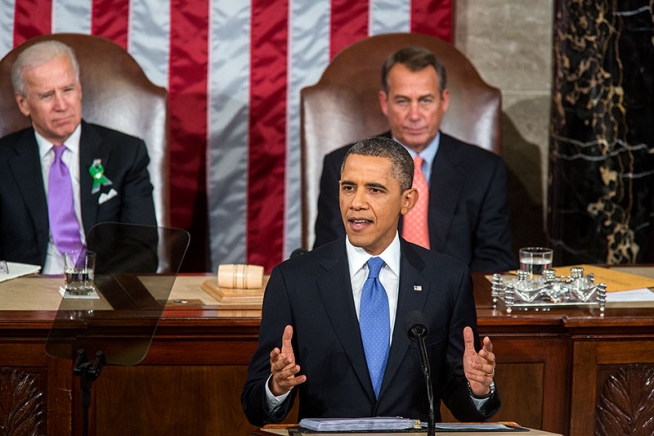Can Obama’s National Network Fill the Missing Middle?
A little over a year after President Obama announced his plans to create a National Network of Manufacturing Institutes (NNMI), it appears that the first spokes are beginning to form around a number of upcoming regional hubs. Just last month the President announced a competition to kickstart the next three institutes, following the successful pilot of the National Additive Manufacturing Innovation Institute (NAMII) in Youngstown, Ohio. And with the recent presentation of the network’s preliminary design document, plans to fill out the remaining 11 designated institutes seem well underway.
 The plan is for each institute to focus on a unique technology that will build upon the existing industrial forte of its region to turn out globally competitive products.
The plan is for each institute to focus on a unique technology that will build upon the existing industrial forte of its region to turn out globally competitive products.
The National Academies’ Government-University-Industry Research Roundtable (GUIRR) co-hosted a series of workshops last fall that, as the name suggests, brought together leaders from government, universities and industry with the goal of giving NNMI a definitive shape that could help it through its launch.
On Tuesday, Brad Kinsey, assistant director for research partnerships at the DOE’s Advanced Manufacturing Office, and Scott Smith, assistant director of technology at the Advanced Manufacturing National Program Office, presented the results of these workshops.
The primary issue that this network aims to address is one we’re all too familiar with: many innovations born in the U.S. are manufactured outside of our borders, causing the nation to lose out on the synergy that occurs between the designing of a product and its manufacturing. Kinsey pointed to this as a growing area of concern, as there is the possibility that by neglecting to pursue this relationship, the nation could lose its driving forces in innovation as well as the manufacturing prowess we once had.
And of course, there are major economic implications as well. For every dollar spent, manufacturing is able to generate $1.45 in other economic sectors, making it the sector with the most value added.
Naysayers may point to manufacturing as only representing 10 percent of U.S. jobs, or only contributing to 12 percent of the GDP, but in terms of generating economic growth, it accounts for 47% of exports, and 70 percent of domestic private-sector R&D.
But of course, this is preaching to the choir. And the federal government has taken note as well, thanks to four advanced manufacturing reports issued by the President’s Council of Advisors on Science and Technology and the National Science and Technology Council over the last two years.
While the first three reports dealt primarily with the state of advanced manufacturing in the United States and what can be done to improve it, the final document, released in January of this year, contains the preliminary design of the NNMI, which was produced via a nationwide crowdsourcing effort that reached nearly 900 organizations and individuals.
Naturally, the first objective was to identify the key problems facing the industry today. Where Kinsey claimed many companies struggle is his version of the “missing middle” that exists between basic research and prototyping and actually taking a product to mass production, which naturally aligns itself with the roughly 300,000 manufacturers in the U.S. employing fewer than 500, for whom traditional methods of R&D and design just aren’t suited.
Kinsey also said this is exactly the space that the NNMI intends to fill.
 While such public-private partnerships will naturally help to boost research efforts, the emphasis on bolstering the workforce has not been forgotten. Together, these Institutes of Manufacturing Innovation (IMIs) could address gaps in not only investment and infrastructure for smaller manufacturers looking to take advantage of the latest technologies, but it could also help to supplement talent by offering unique training programs and research opportunities for students and professionals looking to brush up on their skills.
While such public-private partnerships will naturally help to boost research efforts, the emphasis on bolstering the workforce has not been forgotten. Together, these Institutes of Manufacturing Innovation (IMIs) could address gaps in not only investment and infrastructure for smaller manufacturers looking to take advantage of the latest technologies, but it could also help to supplement talent by offering unique training programs and research opportunities for students and professionals looking to brush up on their skills.
Smith estimated that when tallied together, the workshops allowed over 1,200 voices to give shape to National Network for Manufacturing Innovation: A Preliminary Design. Of those 1,200 in attendance, about 62 percent were divided evenly between industry and academia, which was ultimately reflected in the proposed structure of each IMI.
In broad terms, the structure that was decided upon and put forth in the preliminary design document described physical places that would help academics, and professionals from industry and government to collaborate on advanced manufacturing projects.
Making this all possible is government funding between $70M-$120M over seven years, which must be matched by the private sector. Basic research will be a consistent source of funding throughout this time, with equipment and infrastructure receiving a large part of funding in the first few years, and advanced research taking over toward the end of the seven year span.
According to the document, after this funding period is complete, each IMI should be self-sustained.
Everything from prototyping, technology development and applied research is meant to happen under each institute’s roof. Although the specifics of the yet-to-be-built institutes are still up in the air, just a few areas of focus put forth at the GUIRR workshops were: flexible electronics, nano/micro technology, alternative energy, and modeling and simulation.
While the outline suggests that each focus area fall under manufacturing processes, advanced materials, enabling technologies or industry sectors, this is ultimately up to those submitting proposals.
If you’re wondering who that will be, the design document says that IMIs should be proposed by industry-based non-profit organizations. The proposal should impact multiple companies, industrial sectors or federal agencies, and should reflect the industrial strengths of its region.










